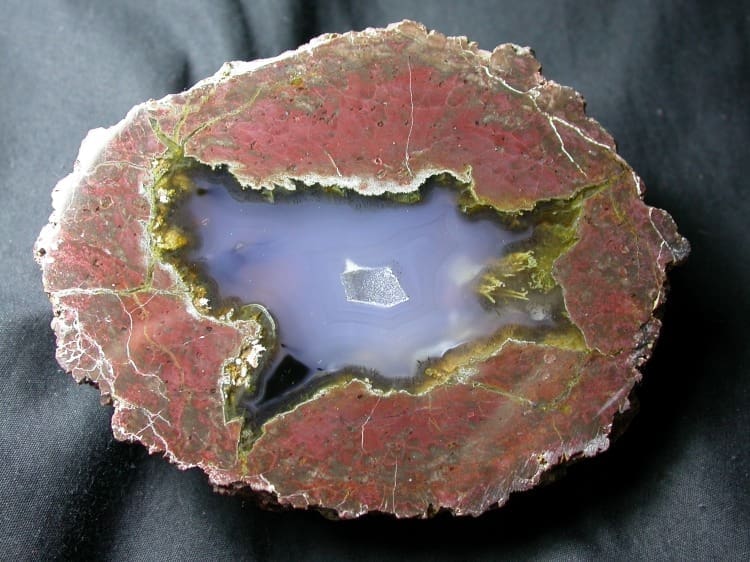Introduction: Unveiling the Mystique of Thundereggs
Thundereggs, often mistaken for ordinary rocks, are geological marvels that hold within them the allure of a rainbow. These unique agates capture the essence of nature’s artistry, found across diverse global landscapes from the Americas to Asia and Australia. Unlike other gemstones that are admired for their clarity and sparkle, thundereggs enchant with their secretive beauty, revealing their splendor only upon being cut open. This characteristic sets them apart, making thundereggs a coveted item among gem collectors and enthusiasts.
The Geological Canvas: Thundereggs’ Formation
The birth of a thunderegg is a narrative of earth’s dynamism, involving volcanic actions that embed these stones within layers of lava. Regions like India, Mexico, and parts of Europe, renowned for their volcanic history, are fertile grounds for these geological treasures. Unlike gems formed under stable conditions, thundereggs embody the chaos and creativity of volcanic eruptions, their colors and patterns a testament to the varying mineral compositions and environmental conditions they were subjected to.
Searching for Thundereggs: Top Destinations
For those seeking the thrill of discovery, Oregon emerges as the thunderegg haven, with its lands generously peppered with these agates, making it a prime destination for collectors. Similarly, California’s gem-rich terrains offer a bounty of thundereggs, accessible to anyone with a keen eye and a spirit for adventure. Venturing beyond the U.S., Mexico, India, and Thailand present themselves as other notable locations, each with its unique geological settings and thunderegg varieties, promising a global treasure hunt.
Why Thundereggs Stand Out Among Gemstones
The allure of thundereggs lies in their unassuming exterior, a stark contrast to the vibrant hidden cores that beckon the curious. This dual nature invites a deeper appreciation, contrasting sharply with more conventional gemstones that wear their beauty on the surface. Moreover, the accessibility and diverse locales where thundereggs can be found add to their appeal, offering a personalized gemstone experience unlike any other.
Conclusion
In conclusion, thundereggs offer a unique narrative in the tapestry of gemstones, bridging the realms of geology and artistry. Their story is one of hidden beauty and geological wonder, resonating with those who seek more than just the superficial allure in their gemstone encounters. By showcasing thundereggs, MiamiMiningCo.com can tap into a niche yet growing interest, drawing visitors into a world where every stone tells a story, waiting to be unveiled.
FAQ
- What are Thundereggs?
- They are unique geological formations, essentially a type of agate that reveals mesmerizing patterns and colors when cut open. They are often found embedded in volcanic ash layers and are prized for their hidden beauty.
- How do Thundereggs differ from other gemstones?
- Unlike traditional gemstones that are valued for their external beauty, clarity, and brilliance, thundereggs possess an unassuming exterior that conceals vibrant, intricate patterns inside. They are appreciated more for their surprise element and natural artistry.
- Where can Thundereggs be found?
- Thundereggs can be discovered across various global locations, including North and South America, Madagascar, Africa, Asia, and Australia. Some notable places include Oregon, California, Mexico, India, and Thailand.
- Why is Oregon considered a prime location for finding Thundereggs?
- Oregon is renowned for its abundant deposits, offering a wide variety of these gemstones. The state’s geological conditions and historical volcanic activity make it an ideal spot for thunderegg enthusiasts.
- Can Thundereggs be found in India and Mexico as well?
- Yes, both India and Mexico have regions rich in volcanic soil where thundereggs can be found. These countries offer distinct varieties, adding to the diversity of thunderegg collections.
- What is the size range of Thundereggs?
- Thundereggs can vary significantly in size, from very small specimens to those as large as 50 centimeters in diameter, catering to different preferences and purposes.
- How are Thundereggs formed?
- They are formed through geological processes involving volcanic activity. The outer shell develops in lava flows, while the inner cavity fills with silica-rich liquids that crystallize to form agate.
- Are Thundereggs valuable?
- The value depends on their size, the beauty of the patterns, and colors inside, and their overall uniqueness. Some can be quite valuable, especially larger pieces with rare and exquisite patterns.
- Can anyone collect Thundereggs?
- Yes, thunderegg hunting is a popular activity for geology enthusiasts and collectors. Public lands in certain areas allow individuals to search for and collect thundereggs, though some locations may require permits.
- How can Thundereggs be used?
- They can be kept in their natural state as geological specimens, or they can be cut and polished to reveal the stunning patterns within, making them popular for jewelry, decoration, or educational purposes.



